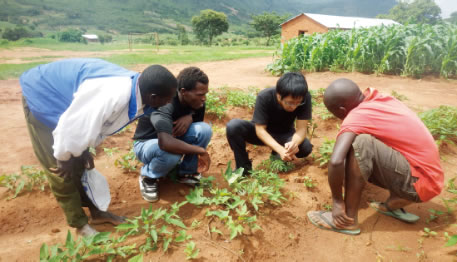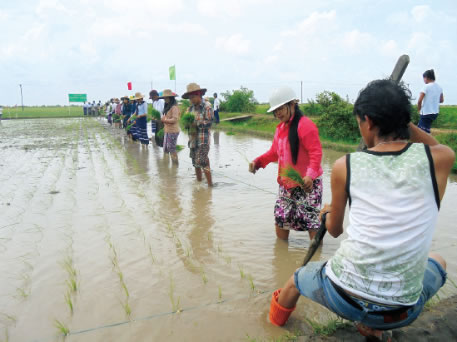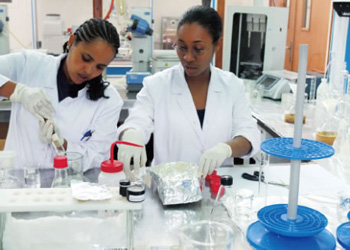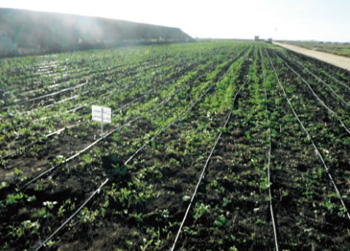(3) Promotion of Agriculture, Forestry and Fisheries, and Development of Food Value Chains
The population of undernourished people in the world still remains large, and the world’s population growth is anticipated to further increase food demand. Under these circumstances, the SDGs in the 2030 Agenda sets Goal 1 as “End poverty in all its forms everywhere” and Goal 2 as “End hunger, achieve food security and improved nutrition, and promote sustainable agriculture,” etc. To achieve these goals and realize quality growth in developing countries, efforts to develop agriculture are an urgent challenge. In addition, three out of four poor people in developing countries live in rural areas. Because the majority of these individuals rely on farming for a living, efforts to develop agriculture and rural communities are important.
<Japan’s Efforts>
Based on the Development Cooperation Charter, Japan proactively addresses global food security, giving priority to cooperation that develops agriculture, forestry and fisheries, including the development of food value chains, in order to achieve “quality growth” in developing countries and poverty eradication through such growth. In the short term, Japan provides food assistance to developing countries to avert food shortages and in the medium- to long-term, Japan aims to help increase and improve agricultural production and productivity in developing countries in order to prevent and eliminate the causes of food-related problems including hunger.
Specifically, Japan uses its knowledge and experience to strengthen agricultural research and technology development, along with capacity-building to disseminate this technology in a way that is suited to the cultivation environment, to promote the sustainable use of fishery resources, to strengthen organizations of farmers, to assist policymaking, as well as to improve infrastructures such as irrigation facilities, farm roads, and fishing ports. Through these efforts, Japan extends various supports, from production, processing, distribution, to sales phases.

Cultivation guidance is carried out as part of the Project for Better Livelihoods and Self-Reliance for Farmers in Mzimba District, in the northern region of Malawi. (Photo: Redson Nyondo / Japan Overseas Cooperative Association)
In Africa, Japan also supports the research of NERICA* (New Rice for Africa) and the spread of its production techniques, and provides support for increasing rice production based on the Comprehensive Africa Agriculture Development Programme (CAADP), and for the introduction of the Smallholder Horticulture Empowerment Project (SHEP) approach,* among others. In addition, in order to assist reducing post-harvest loss,* revitalizing the food industry, and increasing rural incomes, Japan also places priority on assistance for developing “food value chains.” This refers to creating a chain of added values around food by enhancing the added value of agricultural, forestry and fishery products at each phase of the process from production to manufacturing, processing, distribution, and consumption, and linking these added values.
In June 2014, the Ministry of Agriculture, Forestry and Fisheries (MAFF) formulated the Global Food Value Chain Strategy, after conducting reviews in collaboration with academia, private companies, relevant ministries and agencies, and others. The Strategy lays out a basic strategy and region-specific strategies for developing food value chains in developing countries and elsewhere. In accordance with this Strategy, bilateral dialogues were held through public-private cooperation in countries, such as Viet Nam, Myanmar, Brazil, and India to promote the development of food value chains by linking development cooperation and Japanese private sector investment. In August 2015, at the Second High-Level Meeting of the Japan-Viet Nam Agricultural Cooperation Dialogue, the two sides approved a medium- to long-term vision that outlines detailed action plans for developing food value chains in Viet Nam through partnerships between the public and private sectors of Japan and Viet Nam.

Rice planting training is provided as one part of the training for farmers in the Ayeyarwady region of Myanmar. (Photo: Hideo Okada / JICA Expert)
With respect to food security through a multilateral cooperation approach, at the outreach session on food security at the G8 L’Aquila Summit (Italy) in July 2009, Japan pledged at least $3 billion over three years in 2010-2012 for agricultural development including infrastructure, and provided approximately $4.2 billion (commitment basis) by the end of 2012. Additionally, the rapid increase of agricultural investment in developing countries had become an international issue since some of the investments were reported as “land grabbing” by some media outlets. For this reason, Japan proposed the concept of “Responsible Agricultural Investment (RAI)*” at the L’Aquila Summit, which has since gained support at international fora such as the G7/8, G20, and APEC. In addition, based on the RAI concept, the “Principles for Responsible Investment in Agriculture and Food Systems,” having been discussed at the Committee on World Food Security (CFS) supported by a secretariat comprising the Food and Agriculture Organization of the United Nations (FAO), the International Fund for Agricultural Development (IFAD), and the World Food Programme (WFP), were adopted at the CFS 41st Session in October 2014.
As to the New Alliance for Food Security and Nutrition,* which was established at the G8 Camp David Summit (the United States) in May 2012, its progress report was released and additional African partner countries were announced at an event held in conjunction with the G8 Lough Erne Summit (the United Kingdom) in June 2013. Subsequently progress reports have been released every year, and there are now ten partner countries. Furthermore, from 2014 onwards the Alliance has launched its own working groups, which are independent from the G7 process, and is operating autonomously under the New Alliance secretariat of the African Union Commission (AUC). In addition, under the framework of the New Alliance, the relevant international organizations are implementing the “Forward-looking research and analysis programme for responsible agricultural investment” with financial support from Japan.
At the G7 Schloss Elmau Summit (Germany) in June 2015, the Broader Food Security and Nutrition Development Approach was unveiled, which aimed to lift 500 million people in developing countries out of hunger and malnutrition by 2030.
In order to achieve this goal, at the G7 Ise-Shima Summit held under the Japanese presidency in May 2016, the G7 Vision for Action on Food Security and Nutrition was established, summarizing the concrete actions the G7 should take in three prioritized areas (empowering women, improving nutrition through a people-centered approach, ensuring sustainability and resilience within agriculture and food systems). Based on this, an international symposium was held in Tokyo in October 2016, where discussions regarding food security and nutrition were held with the participation of diverse stakeholders.
Furthermore, Japan has provided assistance to the Agricultural Market Information System (AMIS)* in the G20 aiming to enhance international agricultural market transparency. Further, Japan provides assistance in the agricultural sector through the international organizations, such as FAO, IFAD, the Consultative Group on International Agricultural Research (CGIAR), and WFP.
Japan underlines the importance of agriculture as an industry that plays a pivotal role in ensuring food security, reducing poverty, and stimulating economic growth throughout Africa, and contributes to the development of agriculture in Africa.
The Coalition for African Rice Development (CARD)* was established on the occasion of TICAD IV in 2008, and set the goal of an increase of rice production in Sub-Saharan Africa from 14 million tons as of 2008 to twice that amount (28 million tons) by 2018. The annual rice production in Sub-Saharan Africa had increased to 25.16 million tons by 2014, meaning that approximately 74% of the goal has been achieved.
Furthermore, in order to promote a shift from subsistence to profitable agriculture, on the occasion of TICAD V in 2013 Japan announced it would promote the SHEP approach to be applied widely in African countries and develop 1,000 skilled agricultural trainers and organize a smallholders cooperative consisting of 50,000 people through the SHEP approach. By the end of FY2015 the SHEP approach had been rolled out in 20 countries and 1,324 skilled agricultural trainers and approximately 30,000 people in the smallholders cooperative had been trained.
On the occasion of TICAD VI held in August 2016, Japan announced that in order to strengthen food security in Africa, it would transfer rice cultivation skills to 60,000 farmers and 2,500 instructors by 2018 under the CARD initiative, and that it would enhance productivity and profitability of agriculture by promoting market-oriented agriculture and developing the food value chain.
•Ethiopia
The Project for Strengthening of Agricultural Pesticide Residue Analysis System
Technical cooperation project (November 2011 – )

Analysis by the Ethiopian staff members (Photo: JICA)
One of Ethiopia’s major export products is coffee beans, which are exported mainly to Japan. In 2008, pesticides exceeding the maximum residue limits were detected in coffee beans exported to Japan through the monitoring analysis conducted by the Ministry of Health, Labor and Welfare of Japan, which led to Japan’s move to conduct a severe check on pesticide residue. Consequently, Japan’s import of coffee beans from Ethiopia significantly declined, which had a negative impact on the economy of Ethiopia where the agricultural sector accounts for approximately 40% of GDP and more than 90% of its total export value.
For that reason, Ethiopia re-recognized the importance of safety management of food products and established a pesticide residue testing laboratory within the Animal and Plant Health Regulatory Directorate of the Ethiopian Ministry of Agriculture (MoA). However, difficulties surfaced: shortage of the number of experienced pesticide analysts; lack of reagents and solvents for testing; and inability to determine the pesticide contamination route. Under such circumstances, the Government of Ethiopia made a request to Japan to develop human resources to analyze the level of pesticide residue at the testing laboratory.
JICA immediately provided instruments for analyzing pesticide residue and dispatched its staff members capable of both operating the testing laboratory and giving advice regarding human resources development. They began providing technical assistance for the Ethiopians in strengthening their ability to detect the level of pesticide residue at the testing laboratory by increasing the varieties of pesticide to detect and agricultural produce to examine at the laboratory. In particular, when they need to set up policies such as a testing policy, JICA staff aim to create a situation where all the Ethiopian engineers at the laboratory get together to share the techniques and knowledge necessary to analyze reports on agricultural pesticide residue on their own, conduct the monitoring of the level of pesticide residue as necessary and determine whether the export of the product is allowed or not.
Furthermore, the Food and Agricultural Materials Inspection Center (FAMIC) has invited the employees of the testing laboratory to Japan for training, and dispatched its staff members to Ethiopia. It has also provided technical assistance including application skills that are important to cope with trouble that may occur when pesticide residue is being analyzed.
As a result of this support from Japan, basic data for testing has been accumulated in Ethiopia’s pesticide residue testing laboratory, and the Ethiopian staff members involved in testing have mastered the methods for analyzing pesticide residue. Currently voluntary examinations are carried out on all of the coffee beans exported to Japan by the pesticide residue testing laboratory.
Due to Japan’s technology for agricultural pesticide residue analysis and support for human resources development, the safety of the agricultural products of Ethiopia has been strengthened, and it is expected that the experience of Ethiopia will be shared throughout the entire African region. (As of August 2016)
•Morocco
The Project for Improvement of Irrigation System at the Abda Doukkala Irrigated Area
Technical cooperation project (ODA loan project) (July 2011 – July 2016)

The irrigation system installed in the irrigated farmland of Abda- Doukkala. (Photo: JICA)
In Morocco about 13% of GDP is generated by the agriculture sector (2015), which accounts for approximately 11% of the country’s exports and approximately 25% of its working population. However, the greater part of the arable region is arid or semi-arid areas that depends on rainwater and it has been often affected by droughts. Therefore the amount of rainfall has determined agricultural crop yields in the region. As increasing demand for water for industrial use and tap water is expected in the future, it has become an urgent issue for Morocco to improve irrigation facilities for effective and efficient use of limited water resources.
In the Casablanca-Settat region where the Abda Doukkala plain (100-200 kilometers southwest of Casablanca City) lies, about 6,860,000 people live and of those, approximately 1.8 million people (about 26 %) live in rural areas. The total area of farmland in the Casablanca-Settat region accounts for about 66 % of the total land area of the region and about 10% of the rural population is engaged in the agricultural sector.
In 1988 Morocco planned the development of irrigation facilities in this region. In Phase 1 it developed 16,000 hectares of irrigation facilities with financial assistance from the African Development Bank, the European Investment Bank, and the Arab Fund for Economic and Social Development, and in Phase 2 it developed 18,901 hectares of irrigation facilities through an ODA loan project of Japan called the Abda-Doukkala Irrigation Project (completed in 2001).
After the completion of the facilities built with the financial assistance of an ODA loan, Morocco asked Japan for further technical cooperation to transfer the technology on operation and the management of irrigation systems from the Irrigation Association, to improve farm management and access to markets, and to reduce loss resulting from leakage from water resources. These forms of cooperation aim to stabilize agricultural yields through effective use of water resources and improve the livelihood of farmers by increasing their income.
In response to this request, Japan implemented a technical cooperation project, “the Project for Improvement of Irrigation System at the Abda Doukkala Irrigated Area” (2011/7-2016/7). This project supports the establishment of a model at the pilot site in order to encourage the introduction of drip irrigation and high-earning crops on the developed irrigated farmland, and provides support for ascertaining the current situation and future streamlining which are necessary for the improvement of water management systems in the Abda Doukkala irrigated area overall.
This project is also in line with the Green Morocco Plan, a development strategy for the agriculture sector which Morocco is implementing with 2020 as the goal year, and has been positioned as one of the projects promoting the plan.
Currently, the irrigation facilities developed by the ODA loan are being used effectively by approximately 5,700 households engaged in agriculture on the Abda Doukkala plain.
- * New Rice for Africa (NERICA)
- NERICA is a general term for rice developed in 1994 by the Africa Rice Center (formerly West Africa Rice Development Association [WARDA]) through hybridization of high-yield Asian rice with African rice, which is resistant to weeds, diseases and insect pests. Japan has also contributed to developing a variety of new types that are suited to the natural conditions of each region in Africa. The characteristics of the rice include (i) a higher yield, (ii) a shorter growth period, (iii) higher resistance to dryness (drought), and (iv) higher resistance to diseases and insect pests than conventional rice. Since 1997, Japan has partnered with international organizations and NGOs to provide support for research and development related to new types of NERICA, test cultivation, and increased production and popularization of seeds. In addition, Japan has dispatched agricultural experts and JOCVs to offer cultivation training, and has also accepted trainees from Africa for training in Japan.
- * Smallholder Horticulture Empowerment Project (SHEP) approach
- The SHEP approach refers to an effort to assist smallholder farmers to enhance their agricultural organizations through training and research on local markets, and to provide guidance on cultivation techniques and development of agricultural roads while taking account of gender, in order to help them improve their capacities to manage their market-oriented agricultural businesses.
- * Post-harvest loss
- Post-harvest loss refers to harvested food that is discarded, because it is unable to fulfill its originally intended purpose (for use as food, etc.). This can be caused by improper harvest timing, and overexposure to rain or dryness, extremely high or low temperatures, germ contamination, or any other physical damage that reduces the value of the products due primarily to a lack of adequate storage facilities.
- * Responsible Agricultural Investment
- Responsible Agricultural Investment refers to an initiative proposed by Japan at the G8 L’Aquila Summit in response to unintentional negative impacts resulting from large-scale agricultural investment (acquisition of farmland with foreign capital) in developing countries in the face of spikes in international food prices. In addition to mitigating the negative impacts of agricultural investment, it aims to promote agricultural development in the host country of the investment as well as harmonize and maximize the benefits for the host country government, local people, and investors.
- * Agricultural Market Information System (AMIS)
- AMIS was launched as a countermeasure against food price volatility by the G20 in 2011. It allows each of the G20 members, the main exporting and importing countries, companies, and international organizations to share agricultural and food market information (production output, price, etc.) in a timely, precise, and transparent manner. Japan has supported the efforts of ASEAN countries aimed at improving the accuracy of ASEAN statistical information on agriculture used as AMIS data.
- * Coalition for African Rice Development (CARD)
- CARD is a consultative group composed of donor countries, African regional organizations, and international organizations partnered with rice-producing countries in Africa that are interested in rice production and development. The CARD Initiative was announced at TICAD IV in 2008. It has set the goal of doubling rice production in Sub-Saharan Africa (from 14 million tons to 28 million tons) over the ten years until 2018.

A Japan Overseas Cooperation Volunteer, Ms. Ryoko Sahashi (Community Development), works to add value to and commercialize the Loroco flower which is a special product in San Lorenzo Municipality, El Salvador as a part of the One Village One Product Campaign. She visits the Loroco farms for observing its growth. (Photo: Ernesto Manzano / JICA El Salvador)
•Tanzania
Project for Supporting Rice Industry Development in Tanzania
Technical cooperation project (November 2012 – )

A woman harvests rice in a rice field in Tanzania. (Photo: JICA)
In Tanzania, rice is an important crop that boasts the second largest production volume of all cereal crops after corn. The consumption of rice is increasing every year, and domestic production is not keeping up with the growth in domestic consumption so the country is depending on imports from overseas. Given this situation, an increased yield of rice has become an urgent issue. Against this background, the Government of Tanzania established a National Rice Development Strategy in 2009 aimed to increase production of rice, centering on irrigated rice cultivation, and set a goal for 2018 to produce approximately 1,960,000 tons of rice per annum, which is approximately twice the production volume in 2008.
Japan has been contributing to the development of irrigated rice cultivation in the Moshi District in the Kilimanjaro Region since the 1970s and as a result the productivity of rice in the irrigated areas of that district has successfully reached six tons per hectare, much higher than the nationwide average in Tanzania. Since the 1990s, in order to further spread these outcomes nationwide, Japan has implemented training for the improvement of rice productivity based at the Kilimanjaro Agricultural Training Center, and has helped many Tanzanian farmers to achieve increased yields of their rice.
Based on the outcomes to date, this project aims to increase the number of agriculture training centers as footholds and spread irrigated rice cultivation technologies nationwide through the training. Furthermore, from the perspective of poverty reduction the promotion of not only irrigated rice cultivation but also rainfed rice cultivation in paddy fields and in wet lowland is necessary, so the project will develop training techniques for the dissemination of rainfed rice cultivation technologies (including in paddy fields and in wet lowland). Also, taking into consideration the fact that it is necessary to strengthen not only production but also the rice industry value chain including post-harvest processing and marketing, the project will strengthen training pertaining to the rice industry value chain.
Since the commencement of this project, Japan has implemented irrigation technology training in 40 irrigated areas, and implemented training in rice cultivation skills for a total of more than 5,000 farmers. The training has introduced 44 types of rice cultivation skills to the farmers, and of those the major skills such as creating ridges between paddy fields, leveling the paddy fields, and straight-row planting of rice seedlings have been adopted by approximately half of the farmers. In addition, Japan has initiated training in the cultivars of NERICA which can be grown also in rainfed paddy fields, and to date nearly 300 farmers have received this training. Furthermore, whenever a training session is held, consideration is given to the gender ratio to ensure that the same number of male and female farmers participate in the training.
As this project will end in 2018, Japan’s activities are under way to ensure that many farmers employ appropriate rice cultivation skills so that annual rice production in Tanzania can reach more than 2.5 million tons in three years after the completion of the project. (As of August 2016)
